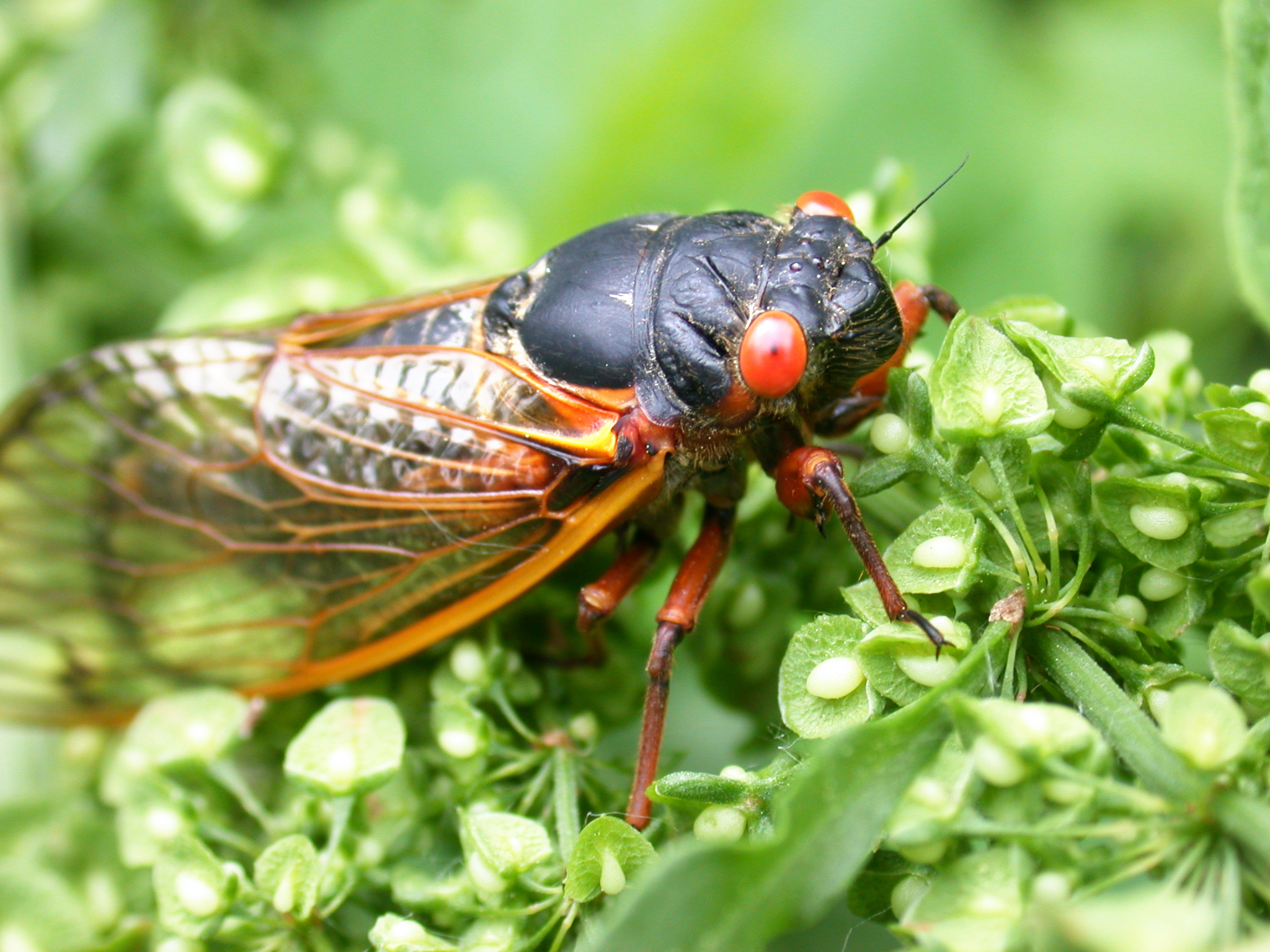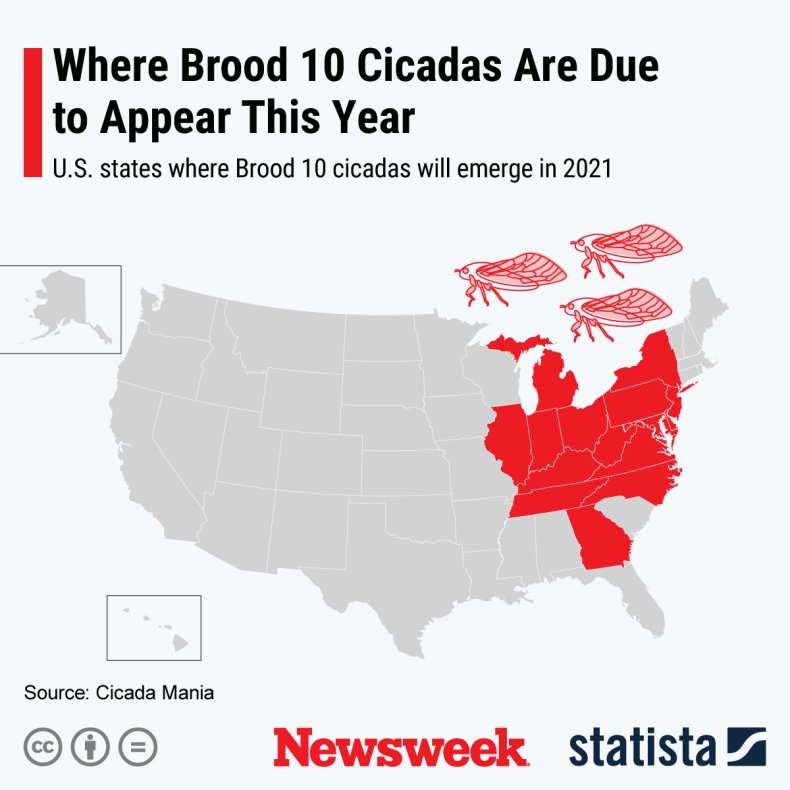They make a lot of noise when they come out to mate, once every 17 years. Here is where they will appear this year.

 www.newsweek.com
www.newsweek.com
After spending almost two decades underground, Brood 10 cicadas are due to appear in U.S. states between Georgia and New York this spring, as reflected in a map created for Newsweek.
The graphic below by Statista shows how people in a sizeable chunk of the U.S. will be able to witness the bugs emerging from their 17-year-long stint of underground activity that started in 2004. During this time, the insects have been living beneath the soil, where they tunnel and live off tree root sap.
From around mid-May to late June, the insects will pop up in Georgia, Kentucky, North Carolina, Virginia, and Tennessee in the south east and south, and Illinois, Indiana, Michigan and Ohio in the Midwest. The northeastern and eastern states of New Jersey, New York, Pennsylvania, and West Virginia will also see the bugs, as well as Delaware and Washington, D.C., in the mid-Atlantic region.
A shower of warm rain usually helps kick off the process, while the soil hitting the right temperature is vital. In 2004, Brood X cicadas were found in dozens of counties in the U.S.

A graphic by Statista shows the U.S. states that can expect to see Brood 10 cicadas in 2021. Statista
This level of spread means Brood 10 is one of the largest colonies of the types of cicadas that appear every 17 years.
Michael J. Raupp, emeritus professor of entomology at the University of Maryland and a fellow of the Entomological Society of America, recently told Newsweektrillions of the insects are expected to appear in the U.S. this year, at densities of 1.5 million per acre in some cases.
Brood 10 is a family of what are known as periodical cicadas, different to those that arrive annually, with almost the entire population crawling from beneath the earth in a single year. According to Raupp, they are genetically programmed to do this.
Ahead of the emergence of Brood 10, experts at the University of Connecticut are inviting members of the public to help them to create accurate maps by reporting where they spot colony members via the Cicada Safari App, available on the Appleand Google Play stores. That's because data on Brood X can be muddied with information about stragglers who emerge off-schedule, including from Brood VI, who occur four years before Brood X, and Brood XIV, who come four years later.
Raupp said: "This is a wonderful opportunity for millions of people to witness and enjoy a remarkable biological phenomenon in their own backyard that happens nowhere else on the planet, truly a teachable moment."

Brood 10 Cicadas Map Shows the U.S. States Where the Insects Will Appear
Trillions of the bugs are due to emerge in parts of the country this spring.
This Brood 10 Cicadas Map Shows the U.S. States Where the Insects Will Appear in 2021
By Kashmira Gander On 1/25/21 at 12:02 PM ESTAfter spending almost two decades underground, Brood 10 cicadas are due to appear in U.S. states between Georgia and New York this spring, as reflected in a map created for Newsweek.
The graphic below by Statista shows how people in a sizeable chunk of the U.S. will be able to witness the bugs emerging from their 17-year-long stint of underground activity that started in 2004. During this time, the insects have been living beneath the soil, where they tunnel and live off tree root sap.
From around mid-May to late June, the insects will pop up in Georgia, Kentucky, North Carolina, Virginia, and Tennessee in the south east and south, and Illinois, Indiana, Michigan and Ohio in the Midwest. The northeastern and eastern states of New Jersey, New York, Pennsylvania, and West Virginia will also see the bugs, as well as Delaware and Washington, D.C., in the mid-Atlantic region.
A shower of warm rain usually helps kick off the process, while the soil hitting the right temperature is vital. In 2004, Brood X cicadas were found in dozens of counties in the U.S.

A graphic by Statista shows the U.S. states that can expect to see Brood 10 cicadas in 2021. Statista
This level of spread means Brood 10 is one of the largest colonies of the types of cicadas that appear every 17 years.
Michael J. Raupp, emeritus professor of entomology at the University of Maryland and a fellow of the Entomological Society of America, recently told Newsweektrillions of the insects are expected to appear in the U.S. this year, at densities of 1.5 million per acre in some cases.
Brood 10 is a family of what are known as periodical cicadas, different to those that arrive annually, with almost the entire population crawling from beneath the earth in a single year. According to Raupp, they are genetically programmed to do this.
Ahead of the emergence of Brood 10, experts at the University of Connecticut are inviting members of the public to help them to create accurate maps by reporting where they spot colony members via the Cicada Safari App, available on the Appleand Google Play stores. That's because data on Brood X can be muddied with information about stragglers who emerge off-schedule, including from Brood VI, who occur four years before Brood X, and Brood XIV, who come four years later.
Raupp said: "This is a wonderful opportunity for millions of people to witness and enjoy a remarkable biological phenomenon in their own backyard that happens nowhere else on the planet, truly a teachable moment."

